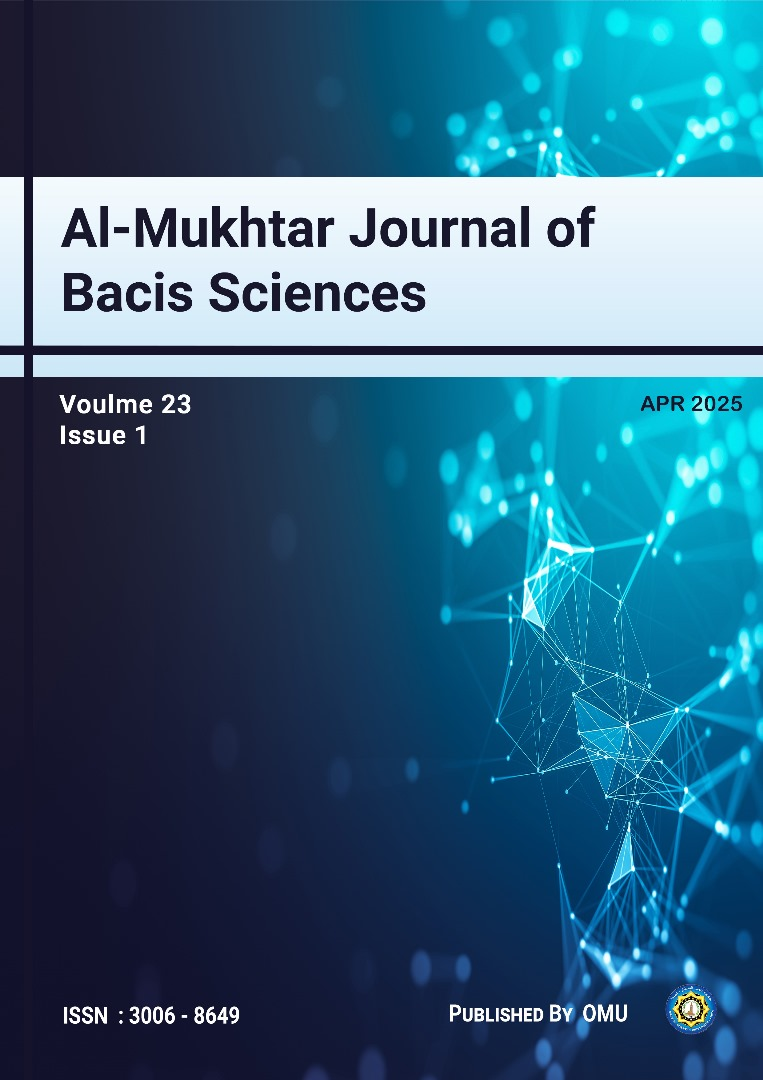Investigation of Pollen Morphology of Malva L. (Malvaceae) in Libya
DOI:
https://doi.org/10.54172/h20j9r95Keywords:
Malvaceae, Malva, Pollen Morphology, Taxonomy, LibyaAbstract
The Malva L. genus belongs to the Malvaceae Juss., which comprises about 40 species. This genus is represented by only six taxa in Libya, namely, Malva aegyptia L., M. sylvestris L., M. verticillata L., M. nicaeensis All., M. parviflora L. var. parviflora and M. parviflora L. var. microcarpa (Pers.) Loscos. In this study, the Malva L. species have been studied and investigated in terms of pollen morphology. Pollen morphology grains have been examined and studied in all taxa using a light microscope. Measurements of pollen diameter, pore diameter and arrangement, pollen shape, and spine features are recorded and comprehensively studied. Palynological results have revealed that pollen grains of Malva species are apolar, spheroidal, and polypantoporate. Pollen grains are characterized by spines, which are long, slender and pointed and/or short and pointed. Inter-spinal distance between apices was a remarkable feature that could be utilized with other features to demarcate species belonging to Malva L.
References
Abdel khalik, K., Al-Ruzayza, S., Assiri, A., & Elkordy, A. (2021). Pollen morphology of Malvaceae genera from Saudi Arabia and its taxonomic significance. Australian Journal of Crop Science, 15(5), 725-742.
Arabameri, M., Mehrabian, A. R., & Khodayari, H. (2023). Pollen morphology of malvaceae in Iran: A case study to complete pollen atlas of Iran. Plant, Algae, Environment, 7(2), 1093-1110.
Bibi, N., Naveed, A., Manzoor, H., & Ajab, K. M. (2010). Systematic implications of pollen morphology in the family Malvaceae from north west frontier province, Pakistan. Pak J Bot, 42, 2205-2214.
Cheema, P. (2018). Palynological studies on some medicinal mallows from Punjab, India. Annals of Plant Sciences, 7(3), 2166-2169.
Christensen, P. B. (1986). Pollen morphological studies in the Malvaceae. Grana, 25(2), 95-117.
Culhane, K. J., & Blackmore, S. (1988). Malvaceae. In'The northwest European pollen flora V'. Elsevier, Amsterdam.[Review of Palaeobotany and Palynology (1988), 57].
El Naggar, S. M. (2004). Pollen morphology of Egyptian Malvaceae: an assessment of taxonomic value. Turkish Journal of Botany, 28(1-2), 227-240.
Erdtman, G. (1952). Pollen morphology and plant taxonomy: angiosperms. Stockholm: Almqvist and Wiksell.
Halbritter, H., Ulrich, S., Grimsson, F., Weber, M., Zetter, R., Hesse, M., Frosch-Radivo, A. (2018). Pollen Morphology and Ultrastructure. In Illustrated Pollen Terminology (pp. 37-65). Springer.
Hosni, H., & Araffa, S. (1999). Malvaceae in the flora of Egypt 2. Pollen morphology and its taxonomic significance. Taeckholmia, 19(2), 147-156.
Jafri, S. M. & Ali, S. I. (1977). Flora of Libya, Malvaceae Volume (10).
Mallick, P. K. (2020). Pollen grains morphology of angiosperms. Int. J. Appl. Sci. Biotechnol., 8(2), 205-210.
Perveen, A., & Qaiser, M. (2007). Pollen Flora of Pakistan-Malvaceae-Grewioideae-LII. Pakistan Journal of Botany, 39(1).
Perveen, A., Siddiqui, S., Fatima, A., & Qaiser, M. (1994). Pollen flora of Pakistan-I, Malvaceae. Pak. J. Bot, 26(2), 421-440.
Saad, S. I. (1960). The sporoderm stratification in the Malvaceae. Pollen et Spores, 2, 13-41.
Shaheen, N., Khan, M. A., Yasmin, G., Hayat, M. Q., & Ali, S. (2009). Taxonomic implication of palynological characters in the genus Malva L., Family Malvaceae from Pakistan. Am. Eurasian J. Agric. Environ. Sci, 6, 716-722.
Downloads
Published
Issue
Section
License
Copyright (c) 2025 Wafia Edrees Abdalrahim, Houssein M. Ali Eltaguri (Author)

This work is licensed under a Creative Commons Attribution-NonCommercial 4.0 International License.
Copyright of the articles Published by Al-Mukhtar Journal of Basic Sciences (MJBS) is retained by the author(s), who grant MJBS a license to publish the article. Authors also grant any third party the right to use the article freely as long as its integrity is maintained and its original authors and cite MJSc as the original publisher. Also, they accept the article remains published by the MJBS website (except in the occasion of a retraction of the article).












